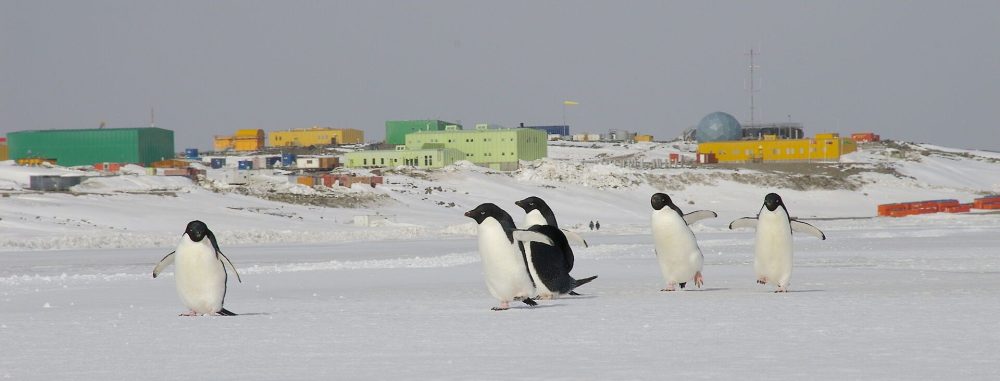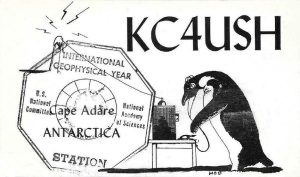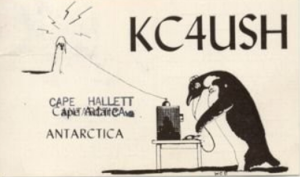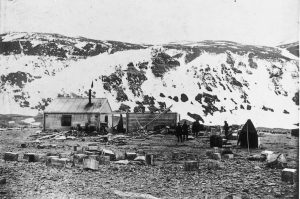 |
 Cape Adare is a prominent cape of black basalt forming the northern tip of the Adare Peninsula and the north-easternmost extremity of Victoria Land, East Antarctica and an important landing site and Base Camp during early Antarctic Exploration.
Cape Adare is a prominent cape of black basalt forming the northern tip of the Adare Peninsula and the north-easternmost extremity of Victoria Land, East Antarctica and an important landing site and Base Camp during early Antarctic Exploration.
Cape Adare is the site of Borchgrevink’s Hut, and Terra Nova Expedition’s Hut where members of the Northern Party of Scott’s Terra Nova Expedition over-wintered in 1911 and 1912. They also erected another hut, which has fallen into ruin today., This site have been designated a Histopric Site or Monument (HSM 22), following a proposal by New Zealand and the United Kingdom to the Antarctic Treaty Consultative Meeting. This site belongs and his administered by New Zealand.
As yet, there is no evidence of amateur radio activity being performed from this site, so it remains listed on WAP-WADA Directory as WAP NZL-NEW.
Map above show both Adare Cape and Hallett Cape
 Cape Hallett, located 63 miles (101 km) to the South of Cape Adare, is a snow-free area on the northern tip of the Hallett Pensula on the Ross Sea coast of Victoria Land, East Antarctica. he cape was the location of a joint scientific base, Hallett Station, (WAP MNB-08) between the United States and New Zealand during the International Geophisical Year of 1957, and was manned permanently until 1964, when there was a major fire. It was then used as a summer only base until 1973.
Cape Hallett, located 63 miles (101 km) to the South of Cape Adare, is a snow-free area on the northern tip of the Hallett Pensula on the Ross Sea coast of Victoria Land, East Antarctica. he cape was the location of a joint scientific base, Hallett Station, (WAP MNB-08) between the United States and New Zealand during the International Geophisical Year of 1957, and was manned permanently until 1964, when there was a major fire. It was then used as a summer only base until 1973.
.
 The callsign of Hallett Base (WAP MNB-08) was KC4USH; with several QSLs issued (See pics here aside); some of KC4USH QSL cards, reports Cape Adare which was probably meant to be Cape Hallett.
The callsign of Hallett Base (WAP MNB-08) was KC4USH; with several QSLs issued (See pics here aside); some of KC4USH QSL cards, reports Cape Adare which was probably meant to be Cape Hallett.
Pic to the Right: Cape Hallett Station in 1961-1962 showing the elevated radar weather-balloon tracking  dome that was reportedly used for plant growth as early as 1958 (Image credit: John Cranfield ©Antarctica New Zealand Pictorial Collection [ANZSC0163.2][1961-1962]).
dome that was reportedly used for plant growth as early as 1958 (Image credit: John Cranfield ©Antarctica New Zealand Pictorial Collection [ANZSC0163.2][1961-1962]).

History
In 1899 the Norwegian explorer Carsten Borchgrevink sailed to Antarctica aboard the converted scaler Southern Cross. At Cape Adare, Borchgrevink and nine companions built a Hut and established an expedition Base Camp. During the next six months, Borchgrevink and his team became the first men to overwinter on the southern continent. A 28-year-old zoologist in the party died and became the first individual buried on the continent. When Borchgrevink returned to Europe in the spring of 1900, he had, in effect, started a race for the South Pole that would be won in 1911 by his boyhood friend, Roald Amundsen.
The site was revisited both by Robert Falcon Scott’s British National Antarctic Expedition (1901-1904) and by his Terra Nova expedition (1910-1913). Pic below show the Borchgrevink’s Hut
 Members of the Northern Party of Scott’s Terra Nova Expedition over-wintered at Cape Adare in 1911 and 1912. They also erected one hut, which has fallen into ruin today. The remains of two Borchgrevink’s Hut, as well as those of the Terra Nova Expedition’s hut, have also been designated a Histpric Site or Monument (HSM#22), following a proposal by New Zealand and the United Kingdom to the Antarctic Treaty Consultative Meeting.
Members of the Northern Party of Scott’s Terra Nova Expedition over-wintered at Cape Adare in 1911 and 1912. They also erected one hut, which has fallen into ruin today. The remains of two Borchgrevink’s Hut, as well as those of the Terra Nova Expedition’s hut, have also been designated a Histpric Site or Monument (HSM#22), following a proposal by New Zealand and the United Kingdom to the Antarctic Treaty Consultative Meeting.
Read more at: Cape Adare Camp Completed | Antarctic Heritage Trust (nzaht.org)
The web shows a book titled “The United States Coast Guard and Borchgrevink’s hut at Cape Adare, Antarctica, 1961. DEEPFREEZE 61 TASK FORCE 43 1961.pdf (navy.mil)
Check page 154/157 for some mention of Cape Hallett/Adare
It was Norwegian explorer, Carsten Borchgrevink and his expedition team who started building the huts on 20 February 1899 on the remote site. The main Living Hut was constructed to house the expedition party along with a Stores Hut for their provisions. The party moved in a few days later, on 1 March, the day the Southern Cross sailed, leaving the men to spend several months in cramped, uncomfortable isolation. On 24 July 1899, it was lucky one of the buildings survived, when a candle set the hut lining alight. Later in the year, one of the men, Nicolai Hanson, suffered a debilitating illness, and died in the hut on 14 October 1899, becoming the first person to die on the Antarctic Continent.
When the Southern Cross returned for the party on 28 January 1900, the men started to dismantle the Stores Hut, removing its roof, with the intention of taking it with them to use elsewhere. However, they left on 2 February 1900 before completing this task and it wasn’t until 18 February 1911 that the Huts at Cape Adare were occupied again, following the arrival of Scott’s Northern Party (led by Victor Campbell). As well as erecting their own kitset wooden hut, they made good use of what was left of Borchgrevink’s encampment, covering the unroofed Stores Hut with canvas to make a storeroom, and utilizing the Living Hut as a gymnasium and darkroom.
Since the Northern Party’s departure from Cape Adare, there have been only sporadic visits to the remote site. New Zealand parties visited a couple of times during the 1960s and 70s to undertake repairs, before Canterbury Museum sent an expedition party to the site in 1982 to carry out maintenance work, complete drawings of the huts, and document the artefacts.
The first party from Antarctic Heritage Trust visited in 1990 and carried out significant preservation works to the huts. This focus continued on the Trust’s next visit in 2003, when condition reports for the artefacts were also completed.
More latterly, during the summer season of 2015–2016, a small team from the Trust spent two weeks at Cape Adare gathering close to 1500 artefacts from one of the huts and carrying out further repairs and maintenance. The artefacts were later conserved in Christchurch, and seven of these very special items now feature on the Trust’s AR App.
More links of Cape Adare at:
Borchgrevink’s Hut | Antarctic Heritage Trust (nzaht.org)
Visitor Site Guidelines – 45. Cape Adare (ats.aq)
 Le cap Adare est un cap important de basalte noir formant le nord
Le cap Adare est un cap important de basalte noir formant le nord
la pointe de la péninsule d’Adare et l’extrémité nord-est de la Terre Victoria , l’Antarctique de l’Est et un site d’atterrissage important et un camp de base pendant
début de l’exploration de l’Antarctique.
Cap Adare est le site de la cabane de Borchgrevink et de la cabane de l’expédition Terra Nova où les membres de la Northern
Une partie de l’expédition Terra Nova de Scott a hiverné en 1911 et 1912. Ils ont également érigé une autre hutte, qui est tombée en ruine aujourd’hui., Ce site a été désigné
Site ou monument historique (HSM 22), suite à une proposition de la Nouvelle-Zélande et du Royaume-Uni à la Réunion consultative du Traité sur l’Antarctique. Ce site appartient et son administration par la Nouvelle-Zélande.
Pour l’instant, il n’y a aucune preuve d’activité de radio amateur à partir de ce site, il reste donc répertorié dans l’annuaire WAP-AMA sous le nom WAP NZL-NEW.
La carte ci-dessus montre à la fois le cap Adare et le cap Hallett
 Cap Hallett, situé 63
Cap Hallett, situé 63
miles (101 km) au sud du cap Adare, est une zone sans neige à l’extrémité nord de la pensée Hallett sur la côte de la mer de Ross de Victoria Land, à l’est
Antarctique. e cap était l’emplacement d’une base scientifique commune, Hallett Station, (WAP MNB-08) entre les États-Unis
et Nouvelle-Zélande pendant l’Année géophysique internationale de 1957, et a été habité en permanence jusqu’en 1964, lorsqu’un incendie majeur s’est déclaré. Il a ensuite été utilisé comme été seulement base jusqu’en 1973.
.
 L’indicatif de Hallett Base (WAP MNB-08) était KC4USH ; avec plusieurs QSL émises (Voir les photos ci-contre) ; certaines des cartes QSL KC4USH, signalent le cap Adare qui était probablement censé être le cap Hallett.
L’indicatif de Hallett Base (WAP MNB-08) était KC4USH ; avec plusieurs QSL émises (Voir les photos ci-contre) ; certaines des cartes QSL KC4USH, signalent le cap Adare qui était probablement censé être le cap Hallett.
Photo de droite : Station Cape Hallett en 1961-1962 montrant le suivi des ballons météo radar en hauteur  dôme qui aurait été utilisé pour la croissance des plantes
dôme qui aurait été utilisé pour la croissance des plantes
dès 1958 (Crédit image : John Cranfield ©Antarctica New Zealand Pictorial Collection [ANZSC0163.2][1961-1962]).

Historique
En 1899, l’explorateur norvégien Carsten Borchgrevink a navigué vers l’Antarctique à bord du scaler reconverti Southern Cross. Au cap Adare,
Borchgrevink et neuf compagnons ont construit une hutte et établi un camp de base d’expédition. Au cours des six mois suivants, Borchgrevink et son équipe sont devenus les premiers hommes à passer l’hiver sur le continent sud. Un zoologiste de 28 ans du groupe est décédé et est devenu le premier individu enterré sur le continent. Lorsque Borchgrevink retourna en Europe au printemps 1900, il avait en effet lancé une course pour le pôle Sud qui serait remportée en 1911 par son ami d’enfance, Roald Amundsen.
Le site a été revisité à la fois par l’expédition nationale antarctique britannique de Robert Falcon Scott (1901-1904) et par son expédition Terra Nova (1910-1913). La photo ci-dessous montre la cabane de Borchgrevink
 Des membres de l’équipe nord de l’expédition Scott’s Terra Nova ont hiverné au cap Adare en 1911 et 1912. Ils ont également érigé une hutte, qui est aujourd’hui en ruine. Les vestiges de deux cabanes de Borchgrevink, ainsi que ceux de la cabane de l’expédition Terra Nova, ont également été désignés site ou monument historique (HSM#22), suite à une proposition de la Nouvelle-Zélande et du Royaume-Uni à la Réunion consultative du Traité sur l’Antarctique.
Des membres de l’équipe nord de l’expédition Scott’s Terra Nova ont hiverné au cap Adare en 1911 et 1912. Ils ont également érigé une hutte, qui est aujourd’hui en ruine. Les vestiges de deux cabanes de Borchgrevink, ainsi que ceux de la cabane de l’expédition Terra Nova, ont également été désignés site ou monument historique (HSM#22), suite à une proposition de la Nouvelle-Zélande et du Royaume-Uni à la Réunion consultative du Traité sur l’Antarctique.
En savoir plus : Cape Adare Camp Completed | Antarctique Heritage Trust (nzaht.org)
Le Web montre un livre intitulé ‘The United States Coast Guard and Borchgrevink’s hut at Cape Adare, Antarctica, 1961. DEEPFREEZE 61 TASK FORCE 43 1961.pdf (navy.mil)
Consultez la page 154/157 pour une mention de Cape Hallett/Adare
C’est l’explorateur norvégien Carsten Borchgrevink et son équipe d’expédition qui ont commencé à construire les huttes le 20 février 1899 sur le site éloigné. La cabane principale a été construite pour abriter le groupe d’expédition ainsi qu’une cabane de magasin pour leurs provisions. Le groupe s’est installé quelques jours plus tard, le 1er mars, jour du départ de la Croix du Sud, laissant les hommes passer plusieurs mois dans un isolement exigu et inconfortable. Le 24 juillet 1899, par chance, l’un des bâtiments a survécu, lorsqu’une bougie a mis le feu au revêtement de la cabane. Plus tard dans l’année, l’un des hommes, Nicolai Hanson, souffrit d’une maladie débilitante et mourut dans la hutte le 14 octobre 1899, devenant ainsi la première personne à mourir sur le continent antarctique.
Lorsque la Croix du Sud est revenue pour la fête du 28 janvier 1900, les hommes ont commencé à démanteler la cabane des magasins, en enlevant son toit, avec l’intention de l’emporter avec eux pour l’utiliser ailleurs. Cependant, ils partirent le 2 février 1900 avant d’avoir terminé cette tâche et ce n’est que le 18 février 1911 que les huttes du cap Adare furent à nouveau occupées, suite à l’arrivée de Scott’s Équipe Nord (dirigée par Victor Campbell). En plus d’ériger leur propre cabane en bois, ils ont fait bon usage de ce qui restait du campement de Borchgrevink, couvrant la hutte de magasin sans toit avec une toile pour faire un entrepôt, et utilisant la hutte vivante comme gymnase et chambre noire.
Depuis le départ de l’équipe nord du cap Adare, il n’y a eu que des visites sporadiques sur le site éloigné. Des équipes néo-zélandaises se sont rendues à quelques reprises au cours des années 1960 et 1970 pour entreprendre des réparations, avant que le musée de Canterbury n’envoie une expédition sur le site en 1982 pour effectuer des travaux d’entretien, achever les dessins des huttes et documenter les artefacts.
La première équipe de l’Antarctic Heritage Trust s’est rendue en 1990 et a effectué d’importants travaux de préservation des cabanes. Cette concentration s’est poursuivie lors de la prochaine visite du Trust en 2003, lorsque des rapports sur l’état des artefacts ont également été rédigés.
Plus récemment, au cours de la saison estivale 2015-2016, une petite équipe du Trust a passé deux semaines au cap Adare à rassembler près de 1 500 artefacts provenant de l’une des huttes et à effectuer d’autres réparations et entretiens. Les artefacts ont ensuite été conservés à Christchurch, et sept de ces objets très spéciaux figurent désormais sur l’application AR du Trust.
Plus de liens du Cap Adare sur :
Cap Adare | Antarctique Nouvelle-Zélande
Cabane de Borchgrevink | Antarctique Heritage Trust (nzaht.org)
Lignes directrices pour les visiteurs du site – 45. Cape Adare (ats.aq)
Info de la Source Publié * ICI
